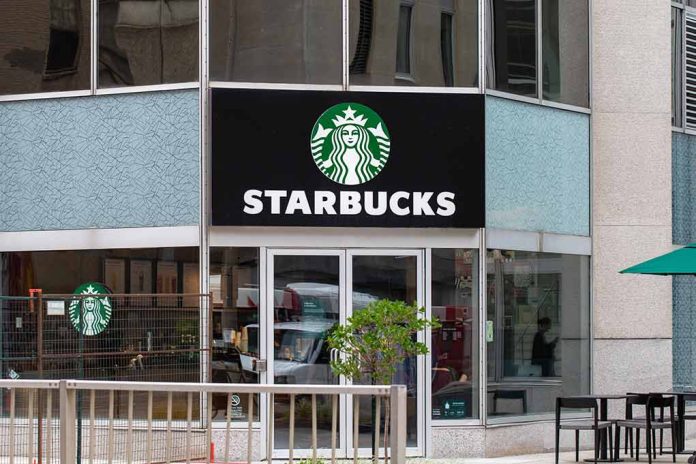🔴 Website 👉 https://u-s-news.com/
Telegram 👉 https://t.me/usnewscom_channel
Gen Z Starbucks baristas are throwing tantrums over a new dress code that simplifies their work attire, exposing a radical disconnect between basic workplace standards and the entitlement mentality plaguing the younger workforce.
Key Takeaways
- Starbucks implemented a more traditional dress code requiring solid black shirts and khaki, black, or blue denim bottoms, sparking immediate backlash from Gen Z workers
- Unionized workers in Seattle staged protests against the dress code, claiming it limits their “self-expression” and is potentially “discriminatory”
- Starbucks is providing two company-branded T-shirts to employees for free to ease the transition
- Critics on social media have dismissed the backlash as “snowflake behavior,” emphasizing that the focus should be on customer service, not employee self-expression
- The controversy highlights the growing divide between traditional workplace standards and younger workers’ expectations
Starbucks Implements Basic Dress Code, Gen Z Erupts
Starbucks has introduced a more conservative dress code policy that requires employees to wear solid black tops with khaki, black, or blue denim bottoms, triggering what many see as a disproportionate response from its younger workforce. The coffee giant’s attempt to create a more consistent customer experience and enhance the visibility of their iconic green apron has unexpectedly revealed a generational fault line in workplace expectations. This seemingly routine corporate decision has ignited fierce opposition from Gen Z baristas who claim their rights to self-expression are being trampled.
The updated policy significantly narrows the previously more permissive dress code, which had allowed a wider range of colors and styles. According to reporting from the New York Post, Starbucks will provide two company-branded T-shirts to each employee at no cost, though this gesture has done little to quell the growing discontent. The reaction from many younger employees has been swift and dramatic, with unionized workers in Seattle organizing protests specifically targeting the new uniform requirements.
The Curious Case for “Self-Expression” in Uniform Policies
Starbucks Workers United, a labor organization representing some employees, has vocally opposed the dress code, labeling it as “regressive” and suggesting it may be discriminatory, particularly against LGBTQ+ employees. This characterization has raised eyebrows among conservatives and traditional workers who view uniforms as a standard aspect of customer service positions. Critics point out that uniform policies have been standard practice in service industries for decades without being considered oppressive or discriminatory.
The labor group claims that management should focus on more pressing issues like understaffing and low wages rather than employee appearance. However, many business experts note that maintaining a professional, consistent appearance is fundamental to brand identity and customer experience. The controversy has illuminated how basic workplace expectations that were once universally accepted are now being reframed as political battlegrounds by progressive activists within the labor movement.
Public Reaction Reveals Cultural Divide
On social media, reaction to the Starbucks dress code controversy has been sharply divided along generational and political lines. Many consumers and older Americans have expressed bewilderment at employees complaining about what they see as reasonable workplace standards. Comments on news articles covering the controversy frequently characterize the objections as “entitled” behavior from a generation unaccustomed to basic workplace requirements.
The Daily Caller reports that numerous online commenters have dismissed the backlash, emphasizing that employees should focus on providing good customer service rather than battling dress codes. One particularly pointed comment noted that uniforms create equality in the workplace by eliminating visible class distinctions based on clothing brands or styles – ironically contradicting the progressive values that many protesters claim to uphold.
The Bigger Picture: Workplace Standards Under Siege
This controversy follows other recent initiatives by Starbucks that have also faced employee resistance, including a policy requiring personalized notes on customer cups. The pattern suggests a fundamental shift in how younger workers view the employer-employee relationship. While previous generations generally accepted that employers had legitimate authority to set workplace standards, including dress codes, the current generation appears to view such policies as optional suggestions that can be rejected if they conflict with personal preferences.
For conservative customers and business owners, the Starbucks dress code debate represents a microcosm of broader cultural shifts threatening traditional workplace norms. Many see the rejection of basic uniform requirements as a troubling sign of declining respect for authority, professionalism, and customer service. As businesses increasingly face pressure to accommodate progressive demands for “self-expression” in all contexts, conservatives worry about the erosion of standards that have long defined American work ethic and professional environments.

